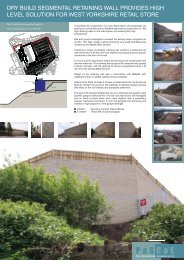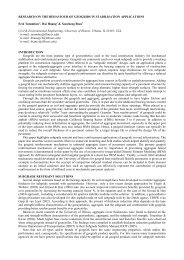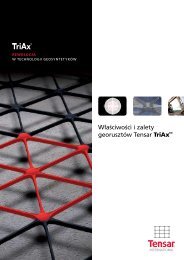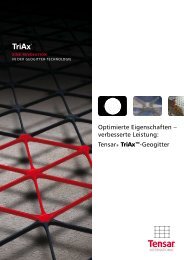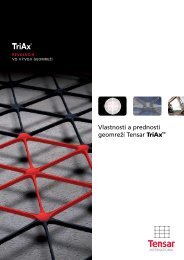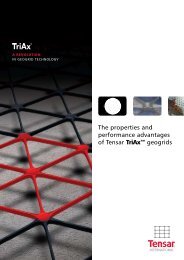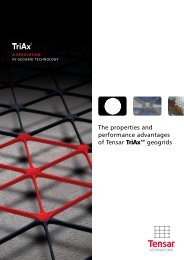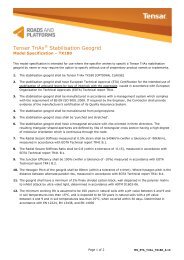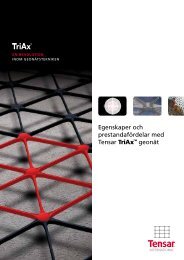3_JP Giroud_edited - Tensar International Ltd.
3_JP Giroud_edited - Tensar International Ltd.
3_JP Giroud_edited - Tensar International Ltd.
You also want an ePaper? Increase the reach of your titles
YUMPU automatically turns print PDFs into web optimized ePapers that Google loves.
using geogrids, it can be inferred that the more sophisticated the decision-maker, the more likely geogrids are to be<br />
selected. Therefore, education of decision makers is likely to benefit geogrids.<br />
Maximum allowable deformation<br />
There are subgrade stabilisation applications where the deformations of the stabilisation structure should be below<br />
strict limits. The most typical example is that of an aggregate layer used as unpaved road during the construction of a<br />
paved road and incorporated in the paved-road structure in the last phase of construction. For the long-term<br />
performance of the paved road, it is important to minimize the deformation of the aggregate layer during the first<br />
phase of construction, i.e. when the aggregate layer is used as unpaved road. (Indeed, the two beneficial effects of<br />
limiting deformations of the aggregate layer during the construction phase are: to maintain the thickness of the<br />
aggregate layer; and to maintain the mechanical properties of the aggregate.) In such cases, design generally plays a<br />
significant role, and generally leads to the recognition of the fact that a geogrid with efficient interlocking with<br />
aggregate provides reinforcement to an unpaved road with significantly less deformation than a geotextile. As a result,<br />
in these applications, geogrids tend to be used more than geotextiles.<br />
Conclusion regarding the comparison of geotextiles and geogrids<br />
Based on the above discussions, it may be concluded that:<br />
• Geotextiles are often preferred to geogrids when separation is needed between the aggregate and the subgrade<br />
soil, and in simple non-designed applications.<br />
• Geogrids are often preferred in sophisticated applications, especially when limited deformations are required,<br />
in particular when the geogrid-reinforced aggregate layer will eventually be incorporated in a paved road.<br />
• In other cases, a design effort would be needed to determine which geosynthetic is the most cost effective.<br />
However, such a design effort is rarely undertaken.<br />
• Sophisticated decision-makers are more likely than others to have experience with (or knowledge of) geogrids<br />
and more likely to use design methods (which are likely to demonstrate that geogrids are cost-effective).<br />
In conclusion, education of decision-makers and development of design methods are likely to benefit geogrids.<br />
Typical arguments used in comparing various types of geogrids<br />
As discussed previously in this paper, it is difficult to objectively compare geogrids of different types, because<br />
their modes of interaction with aggregate are significantly different: some geogrids interact with aggregate primarily<br />
by friction; whereas other geogrids interact with aggregate primarily by interlocking.<br />
Before the advent of triaxial geogrids, only biaxial geogrids were considered for subgrade stabilisation<br />
applications. The situation was then simple. While some suppliers of geogrids promoted the use of tensile strength to<br />
compare geogrids, others promoted the use of properties linked to the junctions between the two sets of ribs, such as<br />
junction strength and aperture stability modulus. In fact, there is no contradiction between these two positions since<br />
tensile strength (or rather stiffness) is possibly the most relevant property for some geogrids, and load transfer between<br />
the two sets of ribs is essential in the case of other geogrids. It is also possible that, for some geogrids that rely<br />
essentially on friction for interaction with aggregate, junction strength may not be an important property for<br />
performance. Perhaps, in the case of purely frictional geogrids, a minimum junction strength to survive construction<br />
without significant damage is sufficient.<br />
There is also some evidence that there may be points of diminishing return with some geogrid properties. As an<br />
example, tests performed with various geometries of triaxial geogrids (and therefore various junction strengths and<br />
aperture stability moduli) have shown that performance tends to decrease beyond a certain geogrid thickness and mass<br />
per unit area and, therefore, a certain junction strength and a certain aperture stability modulus. A tentative explanation<br />
is the following: a thicker and stronger triaxial geogrid is too stiff (and its ribs may be too thick). As a result, it may<br />
cause more disturbance of the soil than a more flexible type of triaxial geogrid of the same manufacture. Essentially, it<br />
appears that, for the type of triaxial geogrid tested, there is an optimum stiffness to better comply with the soil, i.e.<br />
better interact with the soil. This important observation may apply to other geogrid properties (and possibly to other<br />
geogrids) and needs to be better understood through research.<br />
Also, tests have shown that unpaved roads with triaxial geogrids may perform better than similar unpaved roads<br />
with biaxial geogrids of similar manufacture, even though the junction strength and aperture stability modulus are<br />
lower for the triaxial geogrid than for the biaxial geogrid. This is consistent with the above comments on the optimum<br />
stiffness of triaxial geogrids. A tentative explanation is that junction strength and aperture stability modulus are less<br />
important in triaxial geogrids than in biaxial geogrids because there is less need for load transfer between ribs of<br />
different directions in a triaxial geogrid than in a biaxial geogrid. Also, it is possible that triaxial geogrids cause less<br />
distortion to the aggregate structure if they are more isotropic than biaxial geogrids, which can be a research subject.<br />
The above discussions lead to the following tentative conclusion regarding the comparison between various types<br />
of geogrids:<br />
• Frictional geogrids (i.e. geogrids that rely essentially on interface friction) and geogrids that rely essentially on<br />
interlocking cannot be objectively compared using the same property tests.<br />
• Tensile strength (or, better, tensile stiffness) may be more appropriate for characterizing frictional geogrids.<br />
• Junction strength and aperture stability modulus may be more appropriate for characterizing biaxial extruded<br />
geogrids.



